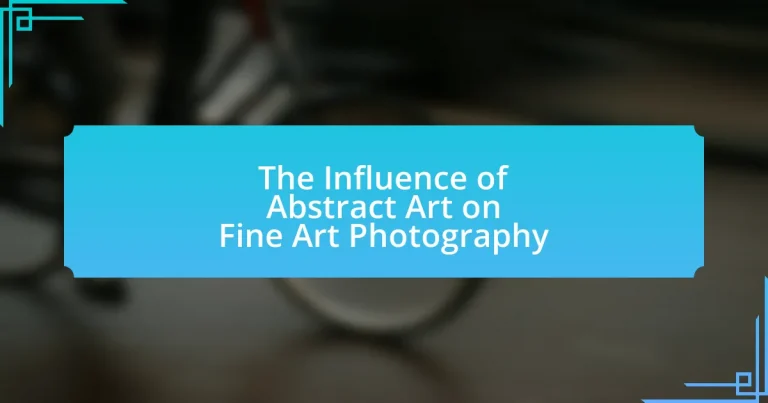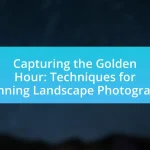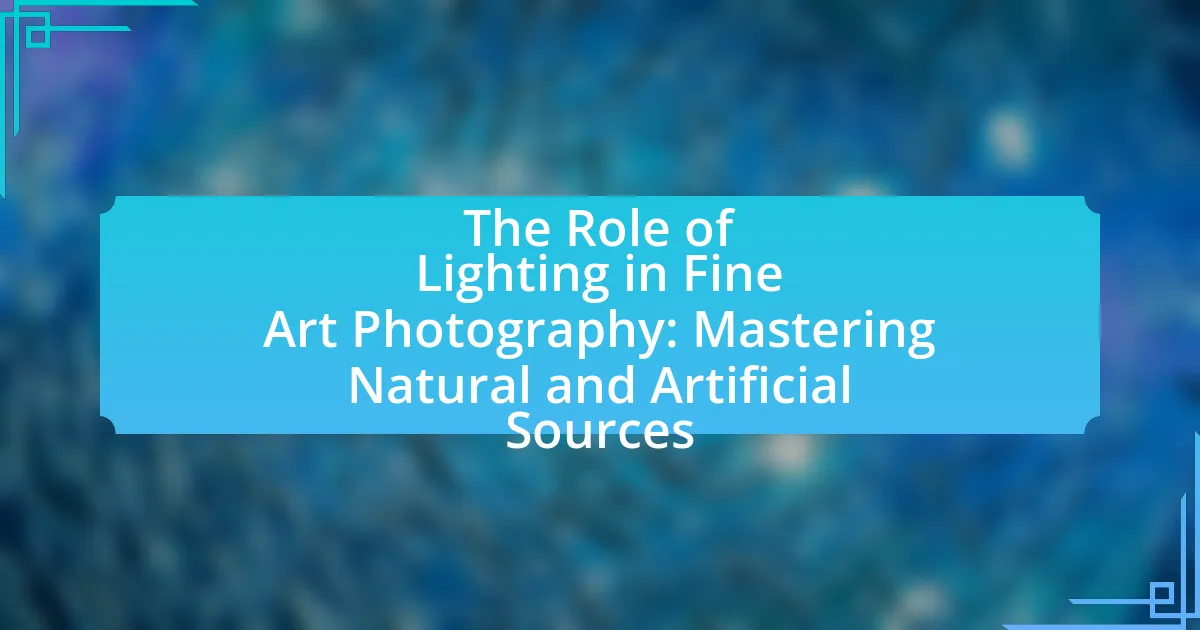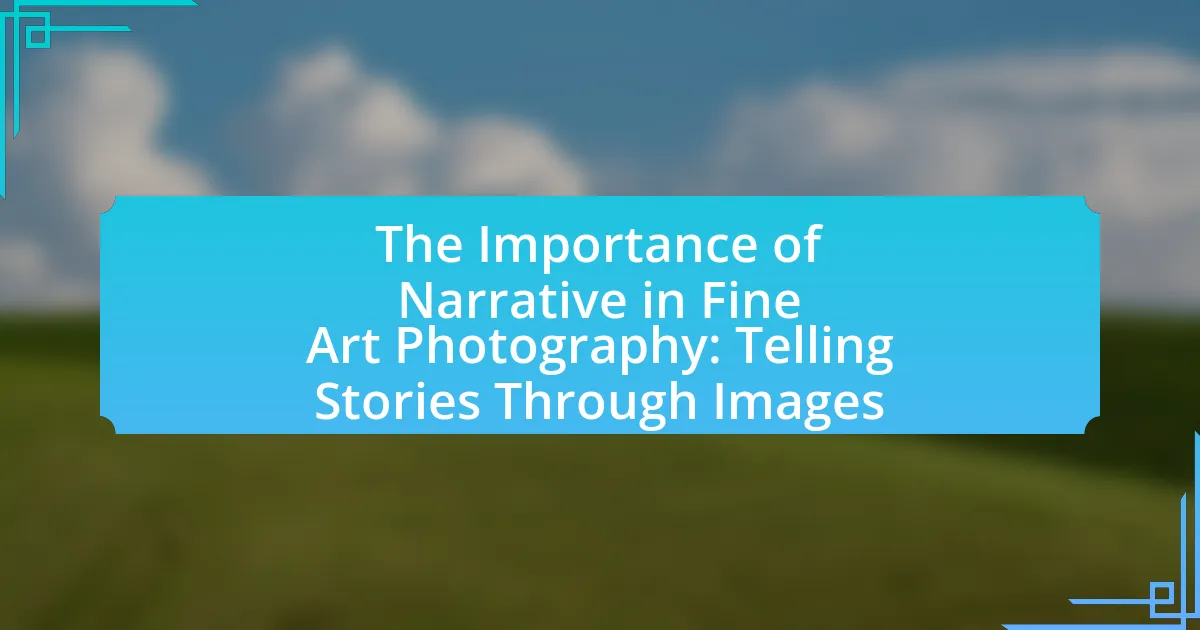The article examines the influence of Abstract Art on Fine Art Photography, highlighting how this movement encourages photographers to explore non-representational forms and focus on visual elements such as color, shape, and texture. It traces the emergence of Abstract Art in the early 20th century, detailing its key characteristics and its challenge to traditional artistic norms. The article also discusses specific techniques adopted by photographers, such as intentional camera movement and long exposure, which align with abstract principles, and emphasizes the importance of this relationship in fostering innovation and expanding the boundaries of visual expression in contemporary photography.

What is the Influence of Abstract Art on Fine Art Photography?
Abstract art significantly influences fine art photography by encouraging photographers to explore non-representational forms and emphasize visual elements such as color, shape, and texture. This influence is evident in the works of photographers like Aaron Siskind and Minor White, who incorporated abstract principles into their compositions, focusing on the emotional and aesthetic experience rather than literal representation. The integration of abstract techniques in photography allows for a broader interpretation of reality, aligning with the modernist movement that seeks to challenge traditional artistic boundaries.
How did Abstract Art emerge as a significant movement?
Abstract Art emerged as a significant movement in the early 20th century as artists sought to break away from traditional representation and explore new forms of expression. This shift was influenced by various factors, including the rise of modernism, technological advancements, and the desire to convey emotions and ideas through non-representational forms. Key figures such as Wassily Kandinsky and Piet Mondrian played pivotal roles in this movement, emphasizing color, shape, and line over realistic depictions. The 1910s and 1920s saw the establishment of Abstract Art as a formal movement, with exhibitions and manifestos that solidified its importance in the art world, ultimately impacting various artistic disciplines, including fine art photography.
What are the key characteristics of Abstract Art?
Abstract art is characterized by its departure from representational forms, focusing instead on shapes, colors, and textures to convey emotions and ideas. This art form emphasizes the use of non-objective elements, allowing artists to express concepts without the constraints of traditional subject matter. Key characteristics include the use of bold colors, dynamic compositions, and an emphasis on the materiality of the medium itself, as seen in the works of artists like Wassily Kandinsky and Piet Mondrian, who pioneered these techniques in the early 20th century. Abstract art often invites subjective interpretation, encouraging viewers to engage with the artwork on a personal level, which has significantly influenced various art movements, including fine art photography.
How did Abstract Art challenge traditional artistic norms?
Abstract Art challenged traditional artistic norms by prioritizing non-representational forms and emphasizing the expression of emotions and ideas over realistic depictions. This movement, which gained prominence in the early 20th century, rejected the conventions of perspective, proportion, and subject matter that had dominated Western art for centuries. Artists like Wassily Kandinsky and Piet Mondrian focused on color, shape, and line to convey meaning, thereby redefining the purpose of art as a medium for personal expression rather than mere imitation of the physical world. The shift towards abstraction not only influenced painting but also had a profound impact on various art forms, including fine art photography, encouraging photographers to explore abstraction in their work.
In what ways has Abstract Art impacted Fine Art Photography?
Abstract Art has significantly influenced Fine Art Photography by encouraging photographers to explore non-representational forms and emphasize visual elements such as color, shape, and texture. This shift has led to the creation of images that prioritize emotional expression and conceptual depth over traditional subject matter. For instance, photographers like Aaron Siskind and Minor White adopted abstract techniques, focusing on the interplay of light and form, which parallels the principles of Abstract Art. This movement has also prompted the use of experimental processes, such as double exposure and manipulation of photographic materials, further blurring the lines between painting and photography. The impact is evident in contemporary practices where photographers often draw inspiration from abstract painters, leading to innovative works that challenge conventional perceptions of reality.
What techniques from Abstract Art are utilized in Fine Art Photography?
Techniques from Abstract Art utilized in Fine Art Photography include the use of color, form, and composition to evoke emotion rather than represent reality. Fine Art Photographers often adopt abstraction by manipulating light, shadow, and perspective to create images that focus on shapes and patterns, similar to abstract paintings. For instance, photographers may employ techniques like long exposure to blur motion, creating a sense of fluidity and movement, which is a hallmark of abstract art. Additionally, the use of unconventional framing and cropping can emphasize certain elements, drawing attention to the interplay of colors and forms, akin to the methods used by abstract artists like Wassily Kandinsky. This approach allows photographers to explore visual language and emotional resonance, aligning their work with the principles of Abstract Art.
How does Abstract Art influence the themes and subjects in Fine Art Photography?
Abstract Art significantly influences the themes and subjects in Fine Art Photography by encouraging photographers to explore non-representational forms and emotional expression. This influence manifests in the use of color, shape, and texture, allowing photographers to convey feelings and concepts rather than literal interpretations. For instance, the works of photographers like Aaron Siskind and Minor White demonstrate how abstract principles can transform ordinary subjects into evocative images that prioritize form and composition over realism. This shift aligns with the historical context of Abstract Art, which emerged in the early 20th century, challenging traditional artistic boundaries and inspiring photographers to adopt similar experimental approaches.
Why is the relationship between Abstract Art and Fine Art Photography important?
The relationship between Abstract Art and Fine Art Photography is important because it fosters innovation and expands the boundaries of visual expression. Abstract Art challenges traditional representation, encouraging photographers to explore new techniques, compositions, and concepts that transcend literal interpretations. For instance, the use of color, form, and texture in Abstract Art has influenced photographers to adopt similar approaches, leading to the creation of images that evoke emotions and provoke thought rather than merely depict reality. This interplay enhances the artistic dialogue between the two mediums, as seen in the works of photographers like Aaron Siskind, who incorporated abstract elements into his photography, thereby bridging the gap between painting and photography.
What does this relationship reveal about the evolution of artistic expression?
The relationship between abstract art and fine art photography reveals that artistic expression has evolved towards greater experimentation and abstraction. This evolution is evident in the way photographers have adopted techniques and concepts from abstract art, such as the use of color, form, and composition to convey emotions rather than representational accuracy. For instance, the works of photographers like Aaron Siskind and Minor White demonstrate how abstract principles can transform photography into a medium that emphasizes subjective experience, paralleling movements in abstract painting. This shift signifies a broader trend in the art world where boundaries between different forms of artistic expression are increasingly blurred, allowing for innovative interpretations and new visual languages.
How does this influence affect contemporary photographers?
The influence of abstract art significantly affects contemporary photographers by encouraging them to explore non-representational forms and emphasize visual elements over literal subject matter. This shift allows photographers to experiment with composition, color, and texture, leading to innovative interpretations of reality. For instance, many contemporary photographers, such as Wolfgang Tillmans and Elad Lassry, incorporate abstract techniques in their work, blurring the lines between photography and painting. This trend reflects a broader movement in the art world where the boundaries of traditional mediums are increasingly challenged, fostering a creative environment that values personal expression and conceptual depth.
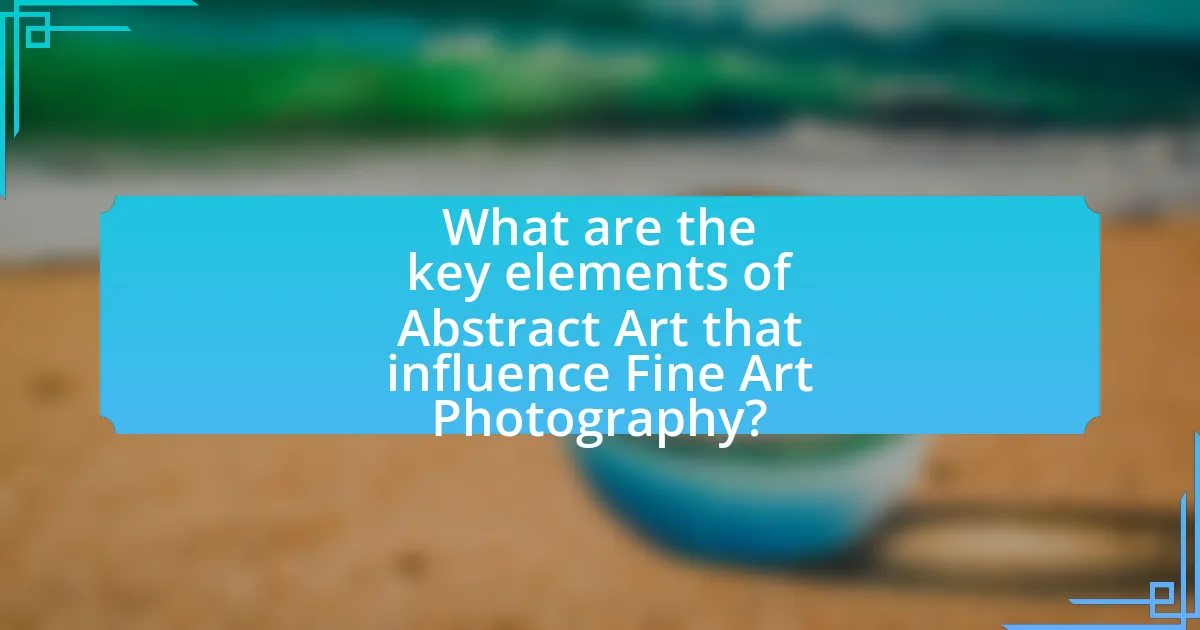
What are the key elements of Abstract Art that influence Fine Art Photography?
The key elements of Abstract Art that influence Fine Art Photography include color, form, and composition. Color in Abstract Art often emphasizes emotional expression, which photographers adopt to evoke feelings in their images. Form, characterized by shapes and lines, allows photographers to explore non-representational subjects, leading to innovative interpretations of reality. Composition in Abstract Art focuses on the arrangement of visual elements, guiding photographers to create dynamic and engaging images that challenge traditional perspectives. These elements collectively encourage photographers to experiment with abstraction, resulting in unique visual narratives that resonate with viewers.
How do color and form play a role in this influence?
Color and form significantly influence the perception and emotional response to fine art photography, as they are fundamental elements that convey meaning and evoke feelings. In abstract art, vibrant colors can create a sense of energy and movement, while muted tones may evoke calmness or nostalgia. For instance, studies show that warm colors like red and yellow can stimulate excitement, whereas cool colors like blue and green often promote tranquility.
Form, on the other hand, shapes the composition and structure of the artwork, guiding the viewer’s eye and influencing their interpretation. Abstract forms can challenge traditional perspectives, encouraging viewers to engage with the piece on a deeper level. Research indicates that the use of geometric shapes in abstract art can lead to a more analytical response, while organic forms may elicit emotional reactions.
Together, color and form in abstract art create a dynamic interplay that informs the aesthetic experience in fine art photography, allowing photographers to explore and express complex themes and emotions.
What are the psychological effects of color in Abstract Art and photography?
The psychological effects of color in Abstract Art and photography significantly influence viewer emotions and perceptions. Colors evoke specific feelings; for instance, warm colors like red and orange can stimulate excitement or passion, while cool colors such as blue and green often promote calmness and tranquility. Research by Andrew Elliot and Markus Maier in their study “Color and Psychological Functioning: A Review of Theoretical and Empirical Work” highlights that colors can affect mood, cognitive performance, and even physiological responses. In Abstract Art, the use of vibrant or contrasting colors can create a sense of energy or tension, while monochromatic schemes may evoke introspection or melancholy. In photography, color choices can enhance storytelling and emotional depth, guiding the viewer’s interpretation of the image. Thus, the strategic use of color in both Abstract Art and photography plays a crucial role in shaping psychological responses and enhancing the overall impact of the artwork.
How does the use of form create visual interest in Fine Art Photography?
The use of form creates visual interest in Fine Art Photography by establishing structure and guiding the viewer’s eye through the composition. Forms, such as shapes, lines, and patterns, can evoke emotions and convey meaning, enhancing the overall aesthetic appeal. For instance, the use of geometric shapes can create a sense of order and harmony, while organic forms may introduce fluidity and dynamism. Research indicates that the human brain is wired to recognize patterns and forms, which can lead to a more engaging visual experience. This principle is evident in the works of photographers like Andreas Gursky, whose large-scale images utilize form to create intricate visual narratives that captivate viewers.
What role does abstraction play in the interpretation of Fine Art Photography?
Abstraction plays a crucial role in the interpretation of Fine Art Photography by allowing viewers to engage with images beyond their literal representation. This engagement encourages personal interpretation and emotional response, as abstract elements can evoke feelings and thoughts that are not tied to specific subjects. For instance, the use of color, shape, and form in abstract photography can create a visual language that communicates ideas and emotions, similar to traditional abstract art. Research indicates that viewers often derive meaning from abstract works based on their own experiences and perceptions, highlighting the subjective nature of interpretation in Fine Art Photography.
How can abstraction alter the viewer’s perception of a photograph?
Abstraction can significantly alter the viewer’s perception of a photograph by emphasizing shapes, colors, and forms over realistic representation. This shift encourages viewers to engage with the image on an emotional or intellectual level rather than a purely literal one. For instance, studies in art psychology indicate that abstract images can evoke a wider range of interpretations and emotional responses, as they allow for personal projection of meaning. This phenomenon is supported by research from the Journal of Experimental Psychology, which found that abstract art can stimulate cognitive engagement, leading to diverse viewer experiences and interpretations.
What are some examples of photographers who embrace abstraction?
Some examples of photographers who embrace abstraction include Aaron Siskind, who is known for his textured and abstract compositions that often resemble paintings, and Minor White, whose work emphasizes the spiritual and emotional aspects of abstraction. Additionally, Wolfgang Tillmans utilizes abstraction in his photography by focusing on color and form rather than traditional subject matter. These photographers demonstrate how abstraction can transform photographic practice, moving beyond representational imagery to explore deeper visual and conceptual ideas.
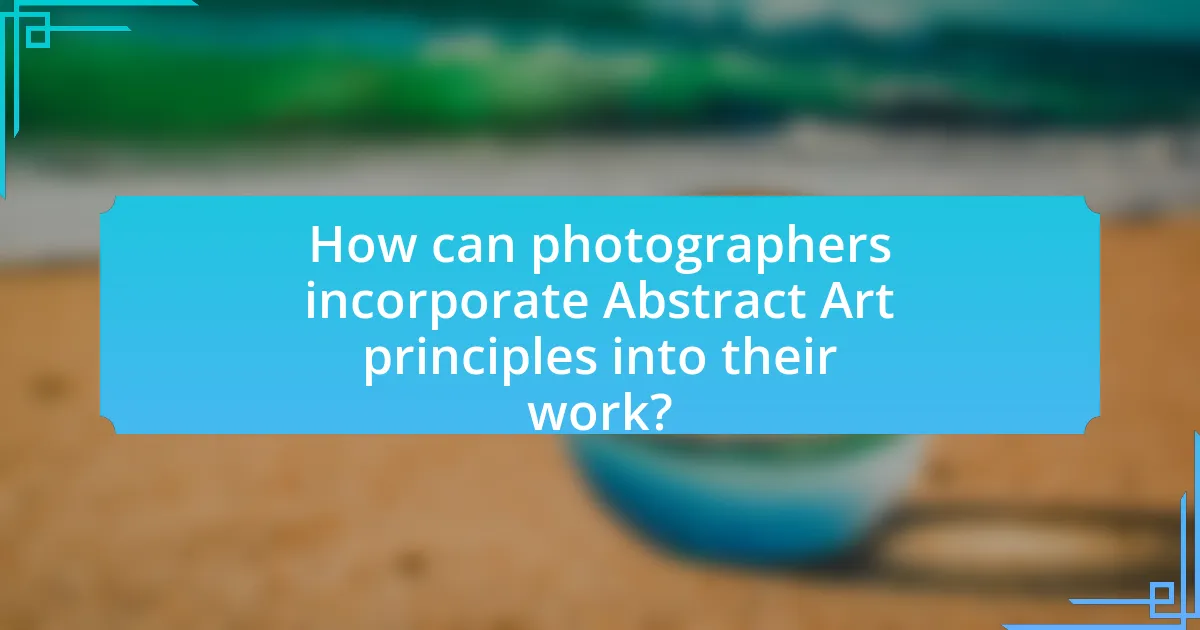
How can photographers incorporate Abstract Art principles into their work?
Photographers can incorporate Abstract Art principles into their work by emphasizing form, color, and texture over representational accuracy. This approach allows photographers to create images that evoke emotions and provoke thought, similar to traditional abstract artists. Techniques such as using unconventional angles, manipulating light and shadow, and employing post-processing effects can enhance abstraction. For instance, photographers like Aaron Siskind and Minor White have successfully utilized these methods to transform ordinary subjects into compelling abstract compositions, demonstrating that abstraction can be achieved through careful consideration of visual elements rather than literal representation.
What techniques can photographers use to create abstract images?
Photographers can use techniques such as intentional camera movement, long exposure, and selective focus to create abstract images. Intentional camera movement involves moving the camera during exposure to blur the subject and create a sense of motion, which can result in unique patterns and colors. Long exposure captures light over an extended period, allowing for the blending of elements in a scene, often resulting in ethereal effects. Selective focus emphasizes certain areas while blurring others, drawing attention to specific details and creating a dreamlike quality. These techniques are widely recognized in the field of photography for their ability to transform ordinary subjects into visually striking abstract compositions.
How can composition be manipulated to achieve an abstract effect?
Composition can be manipulated to achieve an abstract effect by altering elements such as balance, contrast, and perspective. By intentionally disrupting traditional compositional rules, artists can create images that emphasize shapes, colors, and textures over recognizable subjects. For instance, using asymmetrical balance can draw attention to specific areas of the image, while high contrast can enhance visual tension, leading to a more dynamic and abstract interpretation. Additionally, employing unconventional perspectives, such as extreme close-ups or unusual angles, can further abstract the subject, making it less identifiable and more focused on form and color. This approach aligns with the principles of abstract art, which prioritize emotional expression and visual experience over literal representation.
What role does experimentation play in creating abstract photography?
Experimentation is crucial in creating abstract photography as it allows artists to explore unconventional techniques and perspectives. By manipulating elements such as light, composition, and texture, photographers can produce unique visual interpretations that challenge traditional representations. Historical examples, such as the works of Man Ray and Laszlo Moholy-Nagy, demonstrate how innovative methods like solarization and photograms led to groundbreaking abstract images, influencing the evolution of photography as an art form. This emphasis on experimentation fosters creativity and encourages photographers to push boundaries, resulting in diverse and thought-provoking abstract works.
What are some best practices for photographers inspired by Abstract Art?
Photographers inspired by Abstract Art should focus on experimentation with composition, color, and texture to create visually striking images. This approach allows photographers to break traditional boundaries and explore new perspectives, much like abstract artists. Utilizing techniques such as intentional camera movement, double exposure, and macro photography can enhance the abstract qualities of their work. For instance, a study by the International Journal of Arts and Technology highlights that photographers who embrace unconventional methods often produce more innovative and engaging images. Additionally, analyzing the works of renowned abstract artists can provide valuable insights into effective visual language and thematic exploration, further enriching a photographer’s creative process.
How can photographers develop their unique style through abstraction?
Photographers can develop their unique style through abstraction by experimenting with composition, color, and form to create images that emphasize emotion and perception over literal representation. This approach allows photographers to focus on the essence of their subjects, often leading to innovative interpretations that reflect their personal vision. For instance, renowned photographer Aaron Siskind utilized abstraction to transform everyday objects into compelling visual narratives, demonstrating how abstraction can evoke deeper emotional responses and challenge viewers’ perceptions. By embracing techniques such as blurring, cropping, and unconventional angles, photographers can cultivate a distinctive aesthetic that sets their work apart in the realm of fine art photography.
What resources are available for photographers to learn about Abstract Art techniques?
Photographers can learn about Abstract Art techniques through various resources, including online courses, books, and workshops. Online platforms like Skillshare and Udemy offer specific courses focused on Abstract Art photography, providing structured learning and practical exercises. Books such as “Abstract Photography: The New Wave” by David Ward and “The Art of Abstract Photography” by Michael Orton provide in-depth insights and techniques. Additionally, workshops conducted by professional photographers and art institutions often focus on Abstract Art, allowing hands-on experience and direct feedback. These resources collectively enhance understanding and application of Abstract Art techniques in photography.












